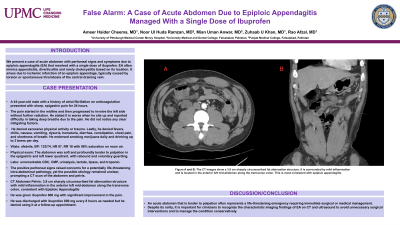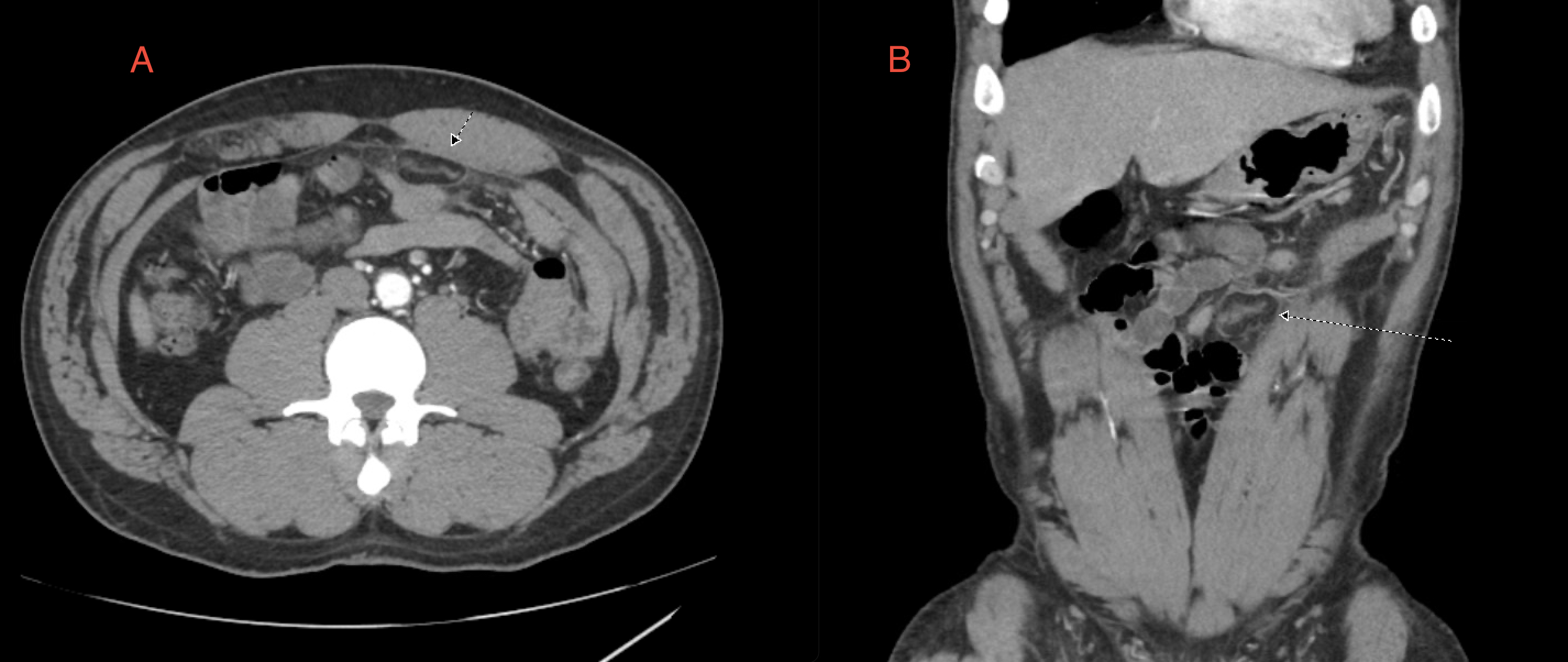Sunday Poster Session
Category: Colon
P0353 - False Alarm: A Case of Acute Abdomen Due to Epiploic Appendagitis Managed With a Single Dose of Ibuprofen
Sunday, October 27, 2024
3:30 PM - 7:00 PM ET
Location: Exhibit Hall E

Has Audio
- AC
Ameer Haider Cheema, MD
University of Pittsburgh Medical Center - Mercy
Monroeville, PA
Presenting Author(s)
Ameer Haider Cheema, MD1, Noor Ul Huda Ramzan, MD2, Mian Uman Anwer, MD3, Zuhaab U. Khan, MD1, Rao Afzal, MD1
1University of Pittsburgh Medical Center - Mercy, Pittsburgh, PA; 2University Medical and Dental College, Pittsburgh, PA; 3Punjab Medical College, Faisalabad, Punjab, Pakistan
Introduction: We present a case of acute abdomen with peritoneal signs and symptoms due to epiploic appendagitis (EA) that resolved with a single dose of ibuprofen. EA often mimics appendicitis, diverticulitis and rarely cholecystitis based on its location. It arises due to ischemic infarction of an epiploic appendage, typically caused by torsion or spontaneous thrombosis of the central draining vein.
Case Description/Methods: 44-year-old male with history of atrial fibrillation on anticoagulation, presented with a sharp, epigastric pain for 24 hours. The pain started in the midline and then progressed to involve the left side without further radiation. He stated it is worse when he sits up and reported difficulty in taking deep breaths due to the pain. He did not notice any clear mitigating factors and also denied excessive physical activity or trauma. Lastly, he denied fevers, chills, nausea, vomiting, dysuria, hematuria, diarrhea, constipation, chest pain, and shortness of breath. He smokes marijuana daily and drinks up to 3 beers per day.
On presentation, vitals were blood pressure 133/74, heart rate 97, respiratory rate 18 with 98% saturation on room air. He was afebrile. Abdominal physical exam showed a soft abdomen, that was profoundly tender to palpation in the epigastric and left lower quadrant with rebound and voluntary guarding. The positive peritoneal signs raised concerns for a potentially life-threatening intra-abdominal pathology, however, labs showed an unremarkable complete blood count, unremarkable complete metabolic profile, lactate of 0.9 mMol/L, lipase of 37 Unit(s)/L, an undetectable troponin, and a urinalysis without abnormalities. The cause of the severe abdominal pain remained unclear which prompted a computed tomography (CT) of abdomen and pelvis. It showed a 3.8 cm sharply circumscribed fat attenuation structure with mild inflammation located in the anterior left mid-abdomen along the transverse colon, consistent with EA. The patient was given ibuprofen 600 mg with significant improvement in the pain. He was discharged with ibuprofen 600 mg every 8 hours as needed but he denied using it at a follow-up appointment.
Discussion: An acute abdomen that is tender to palpation often represents a life-threatening emergency requiring immediate surgical or medical management. Despite its rarity, it is important for clinicians to recognize the characteristic imaging findings of EA on CT and ultrasound to avoid unnecessary surgical interventions and to manage the condition conservatively.

Disclosures:
Ameer Haider Cheema, MD1, Noor Ul Huda Ramzan, MD2, Mian Uman Anwer, MD3, Zuhaab U. Khan, MD1, Rao Afzal, MD1. P0353 - False Alarm: A Case of Acute Abdomen Due to Epiploic Appendagitis Managed With a Single Dose of Ibuprofen, ACG 2024 Annual Scientific Meeting Abstracts. Philadelphia, PA: American College of Gastroenterology.
1University of Pittsburgh Medical Center - Mercy, Pittsburgh, PA; 2University Medical and Dental College, Pittsburgh, PA; 3Punjab Medical College, Faisalabad, Punjab, Pakistan
Introduction: We present a case of acute abdomen with peritoneal signs and symptoms due to epiploic appendagitis (EA) that resolved with a single dose of ibuprofen. EA often mimics appendicitis, diverticulitis and rarely cholecystitis based on its location. It arises due to ischemic infarction of an epiploic appendage, typically caused by torsion or spontaneous thrombosis of the central draining vein.
Case Description/Methods: 44-year-old male with history of atrial fibrillation on anticoagulation, presented with a sharp, epigastric pain for 24 hours. The pain started in the midline and then progressed to involve the left side without further radiation. He stated it is worse when he sits up and reported difficulty in taking deep breaths due to the pain. He did not notice any clear mitigating factors and also denied excessive physical activity or trauma. Lastly, he denied fevers, chills, nausea, vomiting, dysuria, hematuria, diarrhea, constipation, chest pain, and shortness of breath. He smokes marijuana daily and drinks up to 3 beers per day.
On presentation, vitals were blood pressure 133/74, heart rate 97, respiratory rate 18 with 98% saturation on room air. He was afebrile. Abdominal physical exam showed a soft abdomen, that was profoundly tender to palpation in the epigastric and left lower quadrant with rebound and voluntary guarding. The positive peritoneal signs raised concerns for a potentially life-threatening intra-abdominal pathology, however, labs showed an unremarkable complete blood count, unremarkable complete metabolic profile, lactate of 0.9 mMol/L, lipase of 37 Unit(s)/L, an undetectable troponin, and a urinalysis without abnormalities. The cause of the severe abdominal pain remained unclear which prompted a computed tomography (CT) of abdomen and pelvis. It showed a 3.8 cm sharply circumscribed fat attenuation structure with mild inflammation located in the anterior left mid-abdomen along the transverse colon, consistent with EA. The patient was given ibuprofen 600 mg with significant improvement in the pain. He was discharged with ibuprofen 600 mg every 8 hours as needed but he denied using it at a follow-up appointment.
Discussion: An acute abdomen that is tender to palpation often represents a life-threatening emergency requiring immediate surgical or medical management. Despite its rarity, it is important for clinicians to recognize the characteristic imaging findings of EA on CT and ultrasound to avoid unnecessary surgical interventions and to manage the condition conservatively.

Figure: The CT images show a 3.8 cm sharply circumscribed fat attenuation structure. It is surrounded by mild inflammation and is located in the anterior left mid-abdomen along the transverse colon. This is most consistent with epiploic appendagitis.
Disclosures:
Ameer Haider Cheema indicated no relevant financial relationships.
Noor Ul Huda Ramzan indicated no relevant financial relationships.
Mian Uman Anwer indicated no relevant financial relationships.
Zuhaab Khan indicated no relevant financial relationships.
Rao Afzal indicated no relevant financial relationships.
Ameer Haider Cheema, MD1, Noor Ul Huda Ramzan, MD2, Mian Uman Anwer, MD3, Zuhaab U. Khan, MD1, Rao Afzal, MD1. P0353 - False Alarm: A Case of Acute Abdomen Due to Epiploic Appendagitis Managed With a Single Dose of Ibuprofen, ACG 2024 Annual Scientific Meeting Abstracts. Philadelphia, PA: American College of Gastroenterology.
